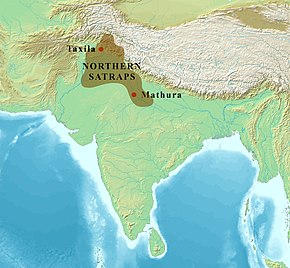
Back Satrapie settentrionali Italian 북사트라프 Korean വടക്കൻ സത്രപർ Malayalam வடக்கு சத்திரபதிகள் Tamil 北部总督 Chinese
Northern Satraps | |||||||||||||||
|---|---|---|---|---|---|---|---|---|---|---|---|---|---|---|---|
| 60 BCE–2nd century CE | |||||||||||||||
The Northern Satraps ruled the area from Eastern Punjab to Mathura.[1] Approximate location and neighbouring polities, early 1st century CE. | |||||||||||||||
| Capital | Sagala/ Mathura | ||||||||||||||
| Religion | Buddhism Hinduism Jainism | ||||||||||||||
| Government | Monarchy | ||||||||||||||
| Historical era | Antiquity | ||||||||||||||
• Established | 60 BCE | ||||||||||||||
• Disestablished | 2nd century CE | ||||||||||||||
| |||||||||||||||
| Today part of | |||||||||||||||
The Northern Satraps (Brahmi: ![]()
![]()
![]() , Kṣatrapa, "Satraps" or
, Kṣatrapa, "Satraps" or ![]()
![]()
![]()
![]()
![]() , Mahakṣatrapa, "Great Satraps"), or sometimes Satraps of Mathura,[2] or Northern Sakas,[1] are a dynasty of Indo-Scythian ("Saka") rulers who held sway over the area of Punjab and Mathura after the decline of the Indo-Greeks, from the end of the 1st century BCE to the 2nd century CE. They are called "Northern Satraps" in modern historiography to differentiate them from the "Western Satraps", who ruled in Sindh, Gujarat and Malwa at roughly the same time and until the 4th century CE. They are thought to have replaced the last of the Indo-Greek kings in the Punjab region, as well as the Mitra dynasty and the Datta dynasty of local Indian rulers in Mathura.
, Mahakṣatrapa, "Great Satraps"), or sometimes Satraps of Mathura,[2] or Northern Sakas,[1] are a dynasty of Indo-Scythian ("Saka") rulers who held sway over the area of Punjab and Mathura after the decline of the Indo-Greeks, from the end of the 1st century BCE to the 2nd century CE. They are called "Northern Satraps" in modern historiography to differentiate them from the "Western Satraps", who ruled in Sindh, Gujarat and Malwa at roughly the same time and until the 4th century CE. They are thought to have replaced the last of the Indo-Greek kings in the Punjab region, as well as the Mitra dynasty and the Datta dynasty of local Indian rulers in Mathura.
The Northern Satraps were probably displaced by, or became vassals of, the Kushans from the time of Vima Kadphises, who is known to have ruled in Mathura in 90–100 CE, and they are known to have acted as Satraps and Great Satraps in the Mathura region for his successor Kanishka (127–150 CE).
- ^ a b Schwartzberg, Joseph E. (1978). A Historical atlas of South Asia. Chicago: University of Chicago Press. p. 145, map XIV.1 (e). ISBN 0226742210.

